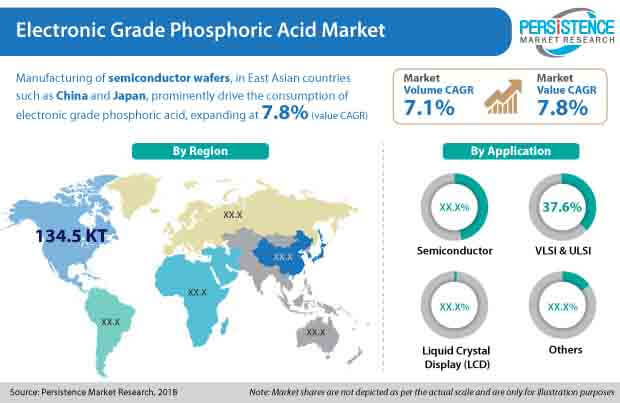Electronic Grade Phosphoric Acid Market Segmented Phosphoric Acid Electronic Grade, food grade phosphoric acid, Electronic Grade Phosphoric Acid
Industry: Chemicals and Materials
Published Date: February-2019
Format: PPT*, PDF, EXCEL
Delivery Timelines: Contact Sales
Number of Pages: 185
Report ID: PMRREP23845
High – purity phosphoric acid employed in electronics and microelectronics manufacturing is known as electronic grade phosphoric acid. Electronic grade phosphoric acid is mainly used in the manufacturing of semiconductors, thin film liquid crystal display panels and large scale integrated circuits, such as VLSI and ULSI, among others.
Electronic grade phosphoric acid is prominently used in wafer etching and cleaning applications. The acidic properties of electronic grade phosphoric acid wash off the impurities from the metal surface, making the metal suitable for use in the electronics industry.
In terms of purity, >80% purity and <80% purity electronic grade phosphoric acids are available in the market. Historically, <80% purity electronic grade phosphoric acid was widely used, while >80% high purity electronic grade phosphoric acid is recently being adopted by end-use industries. >80% high purity electronic grade phosphoric acid finds application as an etchant and cleaning agent in the production of electronic wafers, which are further used to manufacture semiconductors.
On the other hand, <80% electronic grade phosphoric acid finds prominent applications in the cleaning of liquid crystal display panels. This grade type registers high consumption, due to the vast production of LCD panels around the world.
Among applications, the semiconductor segment is anticipated to account for a prominent share in the demand for electronic grade phosphoric acid. Mainly employed in cleaning applications and as an etchant, the demand for electronic grade phosphoric acid is further set to surge over the forecast period.
The global market is estimated to be valued at US$ 827 Mn by the end of 2018 and is expected to reach a market value of over US$ 1.7 Bn by 2028 end, expanding at a CAGR of 7.8% over the forecast period. The global market is anticipated to represent an incremental opportunity worth US$ 930 Mn from 2018 to 2028.
Electronic grade phosphoric acid is mainly employed in semiconductor manufacturing. It can also act as a dopant in PV (photovoltaic) production. Further, it finds application in the manufacturing of fuel cells and display panels such as LCD screens for computers, mobile phones and televisions. Electronic grade phosphoric acid is used in the manufacture of high-quality electronic parts & components.

Regionally, countries of East Asia are prominent regions in the electronic grade phosphoric acid market, due to the significant presence of electronic parts & components manufacturing companies in the region.
Technologically advanced regions such as North America and Europe collectively account for over a 35% share in the market with a rising inclination towards >80% purity electronic grade phosphoric acid. Developing countries of South Asia are anticipated to register a higher growth rate over the forecast period, due to the favorable conditions for emerging businesses and the higher ease of doing business index.
The major players operating in the electronic grade phosphoric acid business vertical are focusing on adopting brownfield investment strategy in an attempt to reduce competition, enhance their market share as well as market presence. For instance, Merck KGaA acquired Sigma-Aldrich to strengthen the global reach of its products. Similarly, Avantor, Inc. acquired VWR Corporation.
The backward integration business model adopted by Israel Chemicals Limited assists the company in maintaining low manufacturing costs pertaining to electronic grade phosphoric acid products.
Cabot Microelectronics, too, follows a backward integrated business model in the electronic grade phosphoric acid marketplace, recently acquiring KMG Chemicals. Solvay SA has much recently ventured in the electronic grade phosphoric acid manufacturing and has been noted to adopt an organic growth strategy.
The supply and demand of electronic grade phosphoric acid in different regions depends on various macro-economic factors affecting the market. However, the production of electronic grade phosphoric acid mainly depends on the mining of phosphate rocks, which is stringently monitored by several environmental and government authorities.
This hinders the continuous production of electronic grade phosphoric acid and may create supply-demand gaps in the future
Some of the players reported in the electronic grade phosphoric acid market study include Solvay SA, Arkema S.A., OCI Company Ltd, Israel Chemicals Ltd., Cabot Microelectronics Corporation, Merck KGaA, RIN KAGAKU KOGYO Co., Ltd., Taiwan Maxwave Co., Ltd., Asia Union Electronic Chemical Corp, SEMIAC Electronic Chemicals Co., Ltd., and Avantor, Inc., among others.
| Attribute | Details |
|---|---|
| Grade |
|
| Application |
|
To know more about delivery timeline for this report Contact Sales
